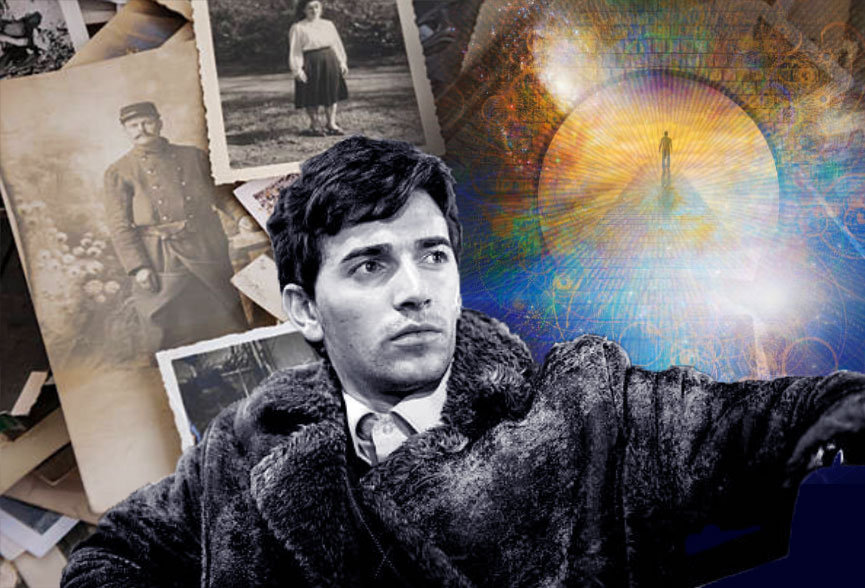The Soul’s Unfinished Business
 by Roger Woolger, Ph.D.
by Roger Woolger, Ph.D.
Working With The Story Behind The Story
The value of remembering past lifetimes is frequently that feelings long buried or blocked can come to the surface and be released. Old fears, as we have seen, can be re-run and found to be baseless: we find that they no longer apply today, that they are simply old stories somehow lodged into the psyche. Generally speaking, it is in lifetimes where there were traumas and severe struggle, or where the life span was cut short, that phobic or traumatic patterns are most likely to be passed on. One of the meanings of the word karma is actually “work”; in contemporary usage I often translate it simply as “the soul’s unfinished business.” The things we failed to do, the setbacks we experienced in one lifetime, seem to be passed on as the soul’s ongoing tasks—work to be redone by the newly incarnating consciousness as it returns to this world in new circumstances and with new opportunities.
Replaying Past Life Scripts
We have seen how old stories, carried quite unconsciously, can become the driving force behind the continuous scripts and compulsive patterns that dominate our current lives. We find ourselves attracting misfortunes, bad relationships, or persistent unhappiness. We all know people, for example, who go from one bad relationship to another, always replaying the same betrayal script; we all know people who are chronically accident-prone.
I was once consulted by a client who had lived with an endless stream of physical accidents, broken bones, and seeming bad luck. Her friends would no longer drive with her because she had been in so many car accidents. When she explored her problem in a regression, she saw herself in a past life as a Polynesian woman about to be crushed by an enormous tidal wave. As the water engulfed her entire village, her terrified dying thought, frozen in her, was, “I’ll never get away from this. It’s going to hit me.” Sure enough, throughout her present life, things kept hitting her: cars and horses and large objects. Only when she let go of the Polynesian woman’s terror did the accidents stop.
Such dire karmic scripts can almost always be traced to some personal tragedy, trauma, or cataclysm in a past life: The loss of those we love. Our possessions destroyed in upheaval or war. Suffering deportation or imprisonment. Being orphaned as a child. Dying of starvation on the street. Invasion, rape, enslavement—they only scratch the surface of “the thousand natural shocks that flesh is heir to,” in the famous words of Shakespeare’s Hamlet. Traumas like these deeply disturb the equilibrium of the soul, leaving parts of it emotionally frozen. They create patterns of suffering that in Sanskrit are called samskaras—deep and bitter scars in the soul that carry over from lifetime to lifetime. Few of us can escape the heritage of psychic scars from emotional and material loss, violence, abuse, abandonment, betrayal, or scapegoating in one lifetime or another. These wounds, rarely healed in the lifetime when they occurred, return, alas, “as instruments to plague us,” as Shakespeare wrote in King Lear, his most devastating play (and one in which karma plays a key part). He also wrote of how the samskaras return with us at birth:
We came crying hither;
Thou know’st the first time that we smell the air
We waul and cry.
So it is no surprise that our first examples—the attack on the Native American camp, the flashback to the Roman arena, and the battlefield—all involved sudden and violent death. Human history is full of invasions, massacres, and atrocities related to times of war and upheaval, and more often than not, past life stories do involve untimely death. None of these stories is pleasant, and few are heroic, but the violent ones need to be rooted out much as a dentist extracts a rotten tooth. Here we will look more closely at past life scars left by premature death in war, violence, and catastrophe, and we will see how careful attention can release their hold on us today.
Where The Soul Goes After Death
We understand death, transition, and rebirth more deeply today than ever, thanks to valuable work in a wide range of traditions. In hospitals, the work of the hospice movement has helped us break the habit of denial and learn to give death its due; the writings of pioneers like Raymond Moody, Kenneth Ring, and Elisabeth Kubler-Ross have given us a remarkable glimpse of what awaits on the other side. In these powerful accounts of near-death experiences, people who clinically died but returned to tell the tale report passing through tunnels to a world of light, where they may have deeply moving reviews of their life on earth, meet spirits of ancestors and other luminous beings, or find themselves guided on awesome trips around the cosmos. Finally, they return to their bodies, usually with great pain, but with their beliefs, their consciousness, and their attitudes to life and death transformed forever. Accounts of past life regression—including those in my own files—chart strikingly similar experiences of passing beyond death, reviewing one’s life, meeting spirits and guides and journeying into other dimensions.
After conducting or observing many, many regressions. I have noted that there are roughly three states the departing spirit or soul may find itself in as it leaves the body:
- Earthbound… The departing spirit stays stuck on earth, either fixed or wandering, unaware that its earthly life has ended.
- Unfinished or troubled… The spirit moves to a higher after-death realm, but in a state of confusion, still obsessed with the life just ended; if this confusion does not clear (and it often does not), it is recycled into a subsequent rebirth.
- Completed or enlightened… The spirit is fully freed from the dross of earthly memories and goes peacefully to an even higher plane, a pure realm of light.
The greater part of the work I do as a therapist working with past lives naturally concerns the first two of these categories, simply because the traumatic and tragic stories, with their fears, failures, and “stuck-ness,” most clearly show us exactly where and how deeply karmic patterns were established, and how they still trouble us today.
To deepen our understanding of the soul’s transition still further, we can look to the wisdom of the Tibetan Buddhist tradition and its teachers in the West. Forty years ago, only scholars of Buddhism (and Carl Jung!) knew much about the Bardo Thodol, or Tibetan Book of the Dead, with its explicit instructions to the soul upon leaving the body at death. Today we have Sogyal Rinpoche’s Tibetan Book of Living And Dying, a superb amplification of the ancient text, in which he explains its archaic symbols in modern psycho-spiritual language to demystify the stages of consciousness that the psyche passes through after death.
In the Tibetan view, the after-death realm—called a bardo (literally, “the in-between”), an intermediary realm in between lifetimes—is a real place. Tibetan tradition teaches that when the spirit leaves the body, it spends a time in this intermediary realm and goes through a series of experiences, partly to help it let go of the lifetime that has passed and partly to prepare it, ideally, for becoming “completed” or “enlightened” and leaving the earth plane altogether. The spirit may be faced with beings, entities, or energies that mirror the unfinished psychological problems of the person who has died. Unless the dying consciousness can assimilate these difficult forces it encounters, it is reborn and sent back to earth. What is extraordinary about the Tibetan teachings is the way in which the consciousness after death is treated as a fully human consciousness, essentially the same as it was when in a body on earth. Sogyal Rinpoche sums it up in one remarkable statement: “Tibetan Buddhism has left us the still revolutionary insight that birth and death are both in the mind and nowhere else.” Ultimately, whether you are in a body or out of a body, mind is continuous.
Birth and death, then, are part of a profound, continuous cycle. The extraordinary work of psychologist Stanislav Grof and others on intrauterine regression reveals that, as the fetus gets closer to the moment of birth and the compression that takes place in the uterus gets stronger, dark and painful memories are stimulated: memories of dismemberment, crucifixion, burning, crushing, and all kinds of horrible death. The birth canal itself is a mirror image of the tunnel that the soul travels through when it leaves the body. Coming back into the body is a reverse tunnel, and a painful one. In my book Other Lives, Other Selves, I have suggested that death, birth, and the realm between form a kind of loop that we go through; the way we come in often mirrors the way we died in a previous lifetime. To take the simplest example: a person born with the umbilical cord wrapped around his neck may, when regressed spontaneously, remember how, in a previous lifetime, he was hanged.
Our Dying Thoughts
In the most common regression experience of dying in a past life—whether in a peaceful or a violent death—the rememberer finds himself or herself leaving the body and simply floating upward. Sometimes the departed spirit hovers over the body, taking in the fact that it is all over; it may stay looking down over the body until the body is buried or cremated. But unlike an “earthbound” spirit, this departed spirit is consciously aware of having died, and this awareness frees the soul to travel up into the higher dimensions of the bardo. The transition can actually be quite beautiful: one sees the earth from above, is shown a panoramic visionary overview of one’s life, and may be shown the progress of loved ones left on earth. Eventually, there is a feeling of having arrived in another dimension, another realm.
But if the circumstances of death have been at all difficult, or if the person was emotionally disturbed in any way before death—resentful, vengeful, guilt, lonely, or fearful, for instance—it is the intensity of those emotions and corresponding thoughts that will go with the departing spirit, obscuring the potentially uplifting and reassuring aspects of the transition. Some years ago, I was struck by a comment W. Evans-Wentz made in his famous early translation of The Tibetan Book of the Dead: “Buddhists and Hindus alike believe that the last thought at the moment of death determines the character of the next incarnation.” From then on, I started to look very carefully during regression work at what people were going through as they were dying in a past life. I found that the death experience and the way people clung to life—dying angry, or bitter, or with despairing thoughts—said a great deal about their attitudes toward living in current lives.
Typical thoughts and feelings that occur at the moment of death have now been recorded from thousands of regressions. “They didn’t want me.” “They didn’t care about me,” are the thoughts of children who had been put out to die or get lost in some kind of attack. “I have to do it alone.” “There’s no one to help me,” say people who are left to struggle and die alone. People who died in a famine say that “There wasn’t enough, there was never enough.” People who were killed for speaking out or crossing some line say, “I should have kept silent.” “I should have kept it to myself.” Others feel guilty: “I could have done more.” “It’s all my fault.” “I didn’t do enough.” Thoughts may be vengeful: “I’ll get back at them.” “I’ll hurt them the way they hurt me.” We may have negative thoughts about ourselves–”I’m no good.” “I was useless.” “I didn’t help them.” “I failed them”–or about some physical failure: “I’ll never walk again.” “I’m trapped.” “I’ll never get out of this.” Someone forced into degrading sexual behavior may say, “I’m disgusting.” Someone who has been betrayed may say, “I’ll never trust anyone again.” “It’s not safe to show what I really feel.” “People will let you down.” “It’s all lies.” When people have died in despair or resigned to hopeless situations such as incarceration or slavery, we hear thoughts that will sow the seeds of depression and negativity in future incarnation: “Why bother to do anything?” “What’s the use?” “They always win.” “It’ll never change.”
Janet: Chronic Pain
A Reminder of Past Brutality
A particularly devastating kind of dying thought, one that we meet not infrequently in past life death scenarios, has to do with guilt and self-hatred. A woman whom I will call Janet had suffered for much of her life from severe pain in her neck and shoulder area. She had done all kinds of bodywork, but the pain never quite went away. She herself was a social worker whose charges were children with learning deficiencies. She was an extremely gentle woman and was very concerned with her clients. But in the past life story she uncovered, she was a slave owner who had brutalized so many slaves that one day a group of them decided to take their revenge. They ganged up on the master, hid behind a building, and, when he emerged, grabbed him and beat him to death. The final, fatal blow was a blow to the neck.
As the slave owner died, he realized very clearly what was going on, how much rage was directed at him, and his dying thought was, “I treated them brutally. These are my just deserts.” When he found himself leaving his body and looking down at it, still being beaten by the angry slaves, he took these thoughts with him: “I shouldn’t have treated human beings in that way. I deserve to be punished.” Not surprisingly, it was the neck and shoulders where the slave owner “took the punishment” and where the residues of the old pain re-imprinted themselves in Janet’s body. Immediately, Janet recognized why she had been carrying this pain in her neck all her life—the physical imprint of the slave owner’s guilt. She was still blaming herself by replaying the old violence against her body. And she was still working in this lifetime to make up for the slave owner’s evil ways by working with children in need of help. Once she could see all of this, and once she was able to help the old slave owner within her talk to the slaves and ask their forgiveness, she felt a huge unburdening of the guilt and the pain.
Sarah: A Lost Brother And The Nazis
“I’ll come and find you.”
Dying thoughts from a past life can have much happier consequences in the present than Janet’s persistent neck pain. A different kind of unfinished business came to light when my client Sarah uncovered her past life as an adolescent Jewish girl in the Second World War. She saw herself reliving the horrors that her small Polish village endured when the community suddenly fell victim to the Nazis. In the chaos, she and her mother tried to hide while her father and older brother, to whom she was deeply attached, fled to the woods with other men to try to form some kind of resistance to the Nazi occupation, but there was no time for the young girl and her other siblings to escape. They were dragged out of hiding, many of them raped, some shot; most of the women and children and elderly were eventually herded into cattle trucks and shipped to concentration camps.
The parting words from her older brother rang in her ears as he headed for the woods: “I’ll come and find you.” But that was the last she heard of him. Eventually she died in the camp, thinking as she went to the gas chamber. “I want to be with my brother. I wish he had come back.” Then, in her present lifetime, Sarah found herself very strongly attracted to a colleague who was married and had his own family (just as she does in this life). She started to work with this colleague; they even formed their own business. They felt incredibly close. And when she finally did her regression, she recognized that this colleague was none other than the brother she had been seeking from that past life. They had indeed found each other; such was the power of those parting and dying thoughts.
Right Living, Right Dying
At the heart of these unfinished thoughts at death are the most primal of human passions. Raw recruits may still be bitter; they died too young on the battlefield; they are angry with the people who condemned them to a worthless death. Others feel profound grief at leaving behind loved ones, regret at not having done more. Obsessive thoughts of revenge may drive the soul back into another incarnation to finish what was started. Although most accounts of near-death experience suggest an automatic review of the lifetime just ended, this is not always the case in past life death scenarios, for if the feelings of revenge are too strong, they may catapult the soul straight into rebirth, bypassing any chance for reflection. Equally obsessive in their way are dying thoughts like Sarah’s, or those of a mother who has lost her son in a massacre and then dies herself, thinking, “I’ve got to find him; I’ve got to be with him.” A thought this determined–”I’ve got to find him”–inevitably means that her soul will follow the soul of her son very quickly into another lifetime, often with no time to review her last life in the realm between lives.
I want to emphasize the simple fact that obsessive past life selves often forget, namely: that past life is done! For people who get caught up too strongly in the thoughts and passions of their past lives, the best reason to remember most past lives is to forget them. Or to put it more simply, in the words of Jalaludin Rumi: A Sufi knows that the past is completely over!
Despite the pain and struggle and karmic imprints of so many difficult lives, our memory banks also hold vivid stories of peaceful lives in which we died painlessly in our beds, surrounded by loving companions–”a consummation devoutly to be wished” (Hamlet again). People with past life experiences of this kind report gently floating into higher realms in the afterglow of a well-lived life, to be greeted by loving beings of light, often ancestors. The Tibetan tradition counsels us that the finest way to die is leave this transient world consciously and peacefully if we can, taking no thoughts, no feelings, no body pains of any kind with us; it teaches us that only when we become completely empty can we know the pure radiance of our limitless minds.
In these wise verses, William Blake summed up the deep reconciliation we can reach with the peaks and valleys of our earthly life:
Man was made for joy and woe;
And when this we rightly know,
Thro’ the world we safely go.
Joy and woe are woven fine,
A clothing for the soul divine.
Excerpt from Healing Your Past Lives
Posted in Other Topics, Past Life Therapy, Reincarnationwith comments disabled.





